
10:39-p.m. 56 mph wind gust 3 miles W. of Silver City (Public report)
10:45-p.m. 59 mph gust 2 miles N. of Tabor (Public report)
10:52-p.m. 67 mph gust 8 miles W/SW of Sidney (DOT instrumentation report)
10:57-p.m. 1″ diameter tree limbs down 3 mile NW of Glenwood (Public)
11:09-p.m. Thunderstorm wind gust 55 mph at Red Oak Airport (AWOS)
11:10-p.m. Montgomery County EMA reports multiple trees, branches and power lines are down in Red Oak
11:11-p.m. 3″ diameter tree limbs broken in Essex. (Public)
11:15-p.m. Thunderstorm wind gust 61 mph 5 miles NW of Shenandoah (AWOS)
11:39-p.m. Thunderstorm wind gust 58 mph at the Clarinda Airport. (AWOS)
11:41-p.m. 60 mph gust in Breda (MesoNet)
12:07-a.m. (10/12) – 50 mph gust recorded in Adel.
12:08-a.m. Cass County Communications reports power outage in Cumberland (Outages also reported in Massena & Lewis)
12:10-a.m. 61 mph gusts in Bedford (MesoNet)
The Montgomery County Emergency Management Agency early this morning reports multiple trees, branches, power lines and other damage is being reported from strong winds that occurred Sunday night into early Monday morning. Officials advise you to “please use caution if you’re out driving and if you have damage on your property, ensure there is no power lines down amongst the tree damage.” In addition, the Iowa DOT reports IA Highway 48 NB/SB: Road blocked due to downed power lines from County Road J28 to County Road J20 (near Essex).
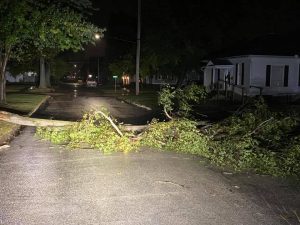
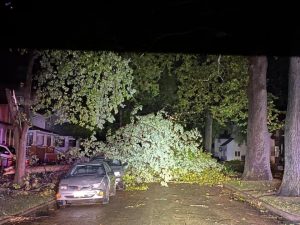

Photos via the Montgomery County EMA Facebook page
DES MOINES, Iowa (AP) — Crop loss estimates from a rare wind storm that slammed Iowa in August have increased by more than 50%. The U.S. Department of Agriculture said Friday that the number of crop acres that Iowa farmers are unable to harvest has grown to 850,000 from estimates last month that 550,000 acres were lost because of the storm, known as a derecho.
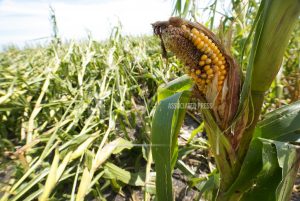
FILE – In this Aug. 20, 2020 file photo, a cornfield damaged in the derecho earlier this month is seen on the Rod Pierce farm near Woodward, Iowa. Crop loss estimates from a rare wind storm that slammed Iowa in August have increased by more than 50%, a new report shows. The U.S. Department of Agriculture said Friday, Oct. 10 that the number of crop acres that Iowa farmers are unable to harvest has grown to 850,000 from estimates last month that 550,000 acres were lost because of the storm, known as a derecho. (AP Photo/Charlie Neibergall, File)
The Des Moines Register reports that the damage caused by winds of up to 140 mph was compounded in late summer with a drought that, at its peak, encompassed much of the state. The drought is again expanding after some September rainfall.
(Radio Iowa) – The U-S Drought Monitor out today (Thursday) shows around 47 percent of the state in moderate drought — and more than two-thirds of the state is still abnormally dry. Iowa D-N-R hydrologist, Tim Hall, says there’s also a surplus of moisture in parts of the state. “It’s kind of a mixed bag in the state. Northeast Iowa has a surplus of water and west-central and southwest Iowa has a deficit of water. On average it’s not too bad. But you really can’t look at averages this year,” Hall says.
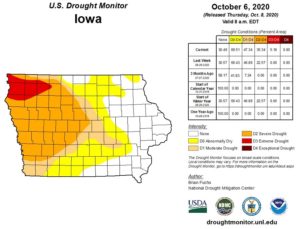 He says central Iowa is doing okay for water — but things change as you move west. “In Audubon, Guthrie, Carroll, Greene, and Shelby counties — driest April to September on record for that part of the state. So those folks in some of those places they are more than 15 inches behind where they should be on rainfall for that time period,” according to Hall. The end of September brought the end of the growing season and concern about the crops having enough water. Hall says the focus now shifts to other water needs.
He says central Iowa is doing okay for water — but things change as you move west. “In Audubon, Guthrie, Carroll, Greene, and Shelby counties — driest April to September on record for that part of the state. So those folks in some of those places they are more than 15 inches behind where they should be on rainfall for that time period,” according to Hall. The end of September brought the end of the growing season and concern about the crops having enough water. Hall says the focus now shifts to other water needs.
“We’re looking ahead towards the next growing season certainly, and we are also looking ahead to the point where the ground freezes up and we have less ability to move water into the soil,” Hall says. “And any water that gets into the soil and eventually into the groundwater typically will end up not just being a source of water for plants, but a lot of communities pump groundwater out and use that for their drinking water supplies,” Hall says rainfall usually slows down this time of year — but any rainfall in the dry areas can help.
“We come out of a dry summer, if we go into a dry fall and the ground freezes up and sort of cuts off the ability of moisture to get down into the soil — folks is those parts of the state who have been really suffering this summer from dryness are going to find themselves in the same dryness hole next spring and it’s going to be hard to get out of,” Halls says. The counties now in extreme drought include Palo Alto, Clay, Dickinson, Osceola, O’Brien, Lyon, Sioux, Plymouth, and Cherokee.
(Radio Iowa) – More than 200 researchers and faculty from 37 colleges and universities in the state have co-signed a statement, suggesting this year’s pandemic, drought and derecho illustrate the importance of having science guide public policy. University of Iowa professor Eric Tate is a lead author on this year’s Iowa Climate Statement. He says the most vulnerable people tend to suffer disproportionately during disasters, so emergency planners should pay attention to how those groups fare during this year’s pandemic. “These are lessons that I think can be directly applied to climate change hazards,” he says.
Tate and the other scientists argue it’s critical for communities to draw up plans in advance to protect lives and property during natural disasters in a changing climate. “Resilient communities and households have a greater ability to withstand disruption and absorb impacts from climate hazards as well as adapt to change,” Tate says. The scientists warn political polarization that has de-legitimized science has made the pandemic worse and it’s important for leaders to promote expert guidance when lives and property are in peril.
(Reporting by Iowa Public Radio’s Amy Mayer)
September Weather data compiled here at the KJAN Studios in Atlantic, show the month was nearly right on the mark for temperatures, but drier than normal. The average High last month was 79 degrees (78.5), while the average Low was 51 (50.7). Rainfall for the month amounted to .66,” whereas we would normally receive 3.81.” The hottest days of the month (over 90 degrees) were on the 3rd, 6th, 7th, and 27th. The coolest temperatures were all in the 40’s, with the lowest of 41 recorded on the 29th and 30th.
Looking ahead to this month (October), Atlantic typically receives 2.76 inches of rain. The High is usually around 64, and the Low is about 39.
KJAN is the OFFICIAL National Weather Service reporting site for Atlantic.
The latest edition of the Iowa Drought Monitor show significant improvements in all categories. The report shows none of the state is currently in extreme drought, and this week, almost 17% more of the state has escaped drought conditions altogether. In western and west central Iowa, the Extreme Drought we’ve been facing for months, was reduced to Severe Drought status.
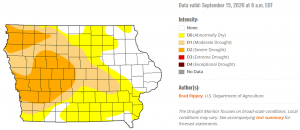 Officials say the dramatic drought improvement came to many areas in the form of a multi-day rain event. Measurable rain fell each day from September 6-12 in Iowa locations such as Dubuque and Davenport, totaling 7.46 and 7.76 inches, respectively. During the same 7-day period, Moline, IL, received 5.97 inches. Broad improvements were introduced where the heaviest rain fell, but some eastern sections of the Midwest remained dry and saw some development or expansion of abnormal dryness (D0). Extreme drought (D3) was erased from Iowa, with only patch of D3 remaining in eastern Nebraska. In contrast, September 1-15 rainfall totaled just 0.04 inch (3% of normal) in Indianapolis, Indiana, and 0.50 inch (32%) in Saint Louis, Missouri.
Officials say the dramatic drought improvement came to many areas in the form of a multi-day rain event. Measurable rain fell each day from September 6-12 in Iowa locations such as Dubuque and Davenport, totaling 7.46 and 7.76 inches, respectively. During the same 7-day period, Moline, IL, received 5.97 inches. Broad improvements were introduced where the heaviest rain fell, but some eastern sections of the Midwest remained dry and saw some development or expansion of abnormal dryness (D0). Extreme drought (D3) was erased from Iowa, with only patch of D3 remaining in eastern Nebraska. In contrast, September 1-15 rainfall totaled just 0.04 inch (3% of normal) in Indianapolis, Indiana, and 0.50 inch (32%) in Saint Louis, Missouri.
DES MOINES, Iowa (AP) — The U.S. Department of Agriculture is estimating that 550,000 acres of Iowa corn will not be harvested this fall due to damage caused by the Aug. 10 wind storm that swept across the state. That estimate places the value of the lost corn crop based on the yield and price anticipated before the storm at around $344 million. Corn prices have gone up due to the crop losses so farmers will likely get more money for the corn they do harvest. Most farmers also have crop insurance to cover some of the loss and other federal programs may help. The soybean crop was largely unaffected.
(Radio Iowa) – After many weeks and — in some areas months — of dry weather and varying degrees of drought, Iowa’s seen several days of steady rain. Lawns that had turned brown are starting to green up again and state climatologist Justin Glisan says the rainfall is in the form that is most beneficial. “If we look at the last seven days, we’ve actually had a good majority of those days where we’ve had measurable rainfall across the state,” Glisan says. “It’s been this gentle rainfall over hours and over days, the kind of rainfall that soaks in.”
While western Iowa has been in the worst shape with drought, that’s the area that’s gotten the least rain, while eastern Iowa is being drenched. “Radar indicated six to eight inches in eastern Iowa between Waterloo, Dubuque and Cedar Rapids,” Glisan says. “You look at the central part of Iowa, estimates of two to three inches, and then moving towards the Iowa-Nebraska border, anywhere from one to three inches.”
Here in Atlantic, as of 7-a.m. today (Friday), rainfall for the week amounts to 2.89-inches. While plentiful in some areas, he says the rain isn’t enough to fully eradicate the drought in Iowa. “In the worst areas of the state, that west-central corridor where we’re seeing D-3 drought, those precipitation deficits go back six to eight months and they’re about eight to 12 inches,” Glisan says. “But, we have had improvement in eastern Iowa where we’ve seen those heavier amounts.”
The rain should continue for many areas of the state at least part-way into the weekend, with dry weather expected next week. Longer range, Glisan says the rest of the month is likely to be cooler and drier than normal, which would be a benefit for farmers and the harvest.